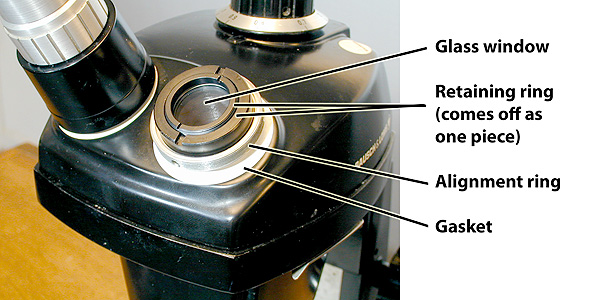
The Bausch & Lomb and Leica StereoZoom 4: Some Technical Notes 2007 Michael A. Covington Author, Digital SLR Astrophotography Overview Unlike a binocular microscope, which feeds one image to both eyes, a stereo microscope gives each eye its own view, so that you see in three dimensions. Stereo microscopes are often used for dissection (hence the alternative term 'dissecting microscope,' not always stereo), inspecting electronic and machine shop work, and handling specimens to prepare slides for more powerful microscopes. One of the most popular stereo microscopes of all time is the Bausch & Lomb StereoZoom 4 (SZ4), later taken over by Leica and also marketed under the Cambridge Instruments name. It was introduced in 1959 and made until 2000. The StereoZoom 4 gives an erect image, provides an ample working distance, and incorporates a zoom system in a self-contained optical 'pod' which could be put on many different bases and mounts. StereoZoom 4's are abundant on eBay and in the rest of the secondhand market today.
Owners Manual Bausch And Lomb Stereo Zoom 4 Parts (edit) Adjusting the Baush & Lomb StereoZoom 4 Microscope. What is most often out. Instructions, manuals. And most manufacturers don’t keep copies of manuals for discontinued microscopes. Bausch & Lomb. Classic Optics. The B&L Standard Teaching Microscope OUT-PERFORMS THEM ALL! Bausch & Lomb guarantee of mate-rials and workmanship, with prompt service through the nation-wide net.
The most common variety of 'pod' zooms from 0.7× to 3×, although 1–3× and fixed-power versions exist. 1 shows how it attaches to a stand; two clips swing out and you can simply lift it off. The eyepieces are normally 10×, non-compensating, with 23.2-mm tubes (the standard size on older microscopes). The eyepieces originally marketed with this microscope are an excellent match to it. Inexpensive non-compensating eyepieces from other vendors also work well. It is quite possible to improvise a stand if you buy a 'pod' by itself. For low-power examination of hand-held specimens, you don't actually need a focusing mechanism; just support the 'pod' far enough above the table and hold the specimen underneath it.
You can use a desk lamp for illumination, but Bausch & Lomb and Leica made a special Nicholas (collimated-beam) illuminator that could be used separately or inserted into a hole in the back of the 'pod' (Fig. There is also a transillumination base for the StereoZoom 4 that accepts that same illuminator as its light source. The Nicholas illuminator has one quirk: dust on the innermost lens surface, near the bulb, is projected sharply into the spot of light. Accordingly, a standard maintenance procedure is to open it up and swab the dust out. Photography Although it is not trinocular, the StereoZoom 4 is easy to use for photography. Any camera adapter that will fit a standard eyepiece tube is suitable.

I prefer to use afocal coupling (that is, camera lens aimed into eyepiece) with a Nikon Coolpix 800 or 990. Adjustments Some of the adjustments of the StereoZoom 4 are not widely known. In what follows I'll review all the adjustments that can be done without disassembly. 3 Eyepiece focusing There are adjusting rings around both eyepiece barrels (Fig. The one on the left turns freely and is used to make both eyes focus alike. The one on the right is secured with a set screw and serves to make the focus stay the same while zooming. Here is the procedure for adjusting both of them: (1) Place a flat specimen, such as a printed page, under the microscope, and zoom to maximum power.
(2) Using only your right eye, focus the microscope. Ignore the image in the left eye.
(3) Loosen the set screw on the right adjusting ring. (4) Zoom to minimum power and see if the image in your right eye remains in focus. If not, turn the right adjusting ring until it does. Repeat this process several times.
(4) Tighten the set screw. Further adjustment of the ring on the right will not be needed unless you change eyepieces. Software Program Kasir Bahan here. (5) Turn the left adjusting ring so that the image in the left eye is also in focus. You can turn the left adjusting ring at any time without disturbing any other adjustment. As with most binocular microscopes, you can adjust the separation of the eyepieces at any time by just pulling them apart or pushing them together. When doing this, grasp the base of the barrel (painted black, white, or gray), not the adjusting ring. 4 Alignment (Eyepiece Centering) Misalignment of the StereoZoom 4 is surprisingly easy to correct.
A stereomicroscope is said to be misaligned when the two eyes are not looking quite in the same direction. If minor, the problem may go unnoticed, or you may simply feel that the microscope is tiring to use, or that no eyepiece separation is quite right. A StereoZoom 4 that has had its top cover removed will almost certainly be out of alignment unless it was aligned after reassembly. To test alignment, put a flat specimen, such as a printed page, under the microscope and compare the view in the right and left eyes. (If you use a three-dimensional specimen, the views will certainly be different; that's stereoscopy.) If your two eyes see the same or almost the same field of view, no adjustment is needed. But if there's a substantial discrepancy, proceed as follows. First try to describe the problem: 'Image in the right eye needs to move up and to the left' or the like.